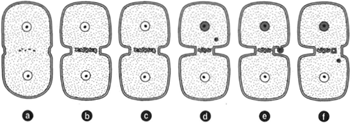Floridiophycidae
Floridiophyceae is by far the larger of the two Rhodophyceae subclasses, encompassing approximately 3,900 species. A prominent characteristic among this subclassis the presence of cytoplasmic strands that connect adjacent cells. Such strands are called primary pit connections. As shown in figure 15-2a and b, the nucleus of the cell divides, and the nuclei migrate to opposite ends of the cell. A constriction then develops in the cell wall. Thus, division is not completed; while the cells are separate cells, they are not separated cells.Figure 15-2 shows yet another rather amazing event that may occur, resulting in secondary pit connections. The nucleus of the cell divides, and one of the daughter nuclei migrates to the lower edge of the cell (figure 15- 2d). Here, in response to the presence of the nucleus, a protuberance grows out from the cell wall (figure 15- 2e). The nucleus then moves into this outgrowth. As this outgrowth continues to expand, it comes in contact with the neighboring cell wall, which is thus dissolved. The result is an open channel to the cell below through which the nucleus continues its passage into the lower cell (figure 15-2f). Why doesn’t the nucleus either go through the opening that is already there or stay in its original place? Although the answers to such questions are unknown, the events are enchanting to observe. Figure 15-2 shows secondary pit connections only between sister cells, but such connections also occur between cells that are not sisters.
 |
| Figure 15-2 Pit connections. At (a), (b), and (c), the primary pit connection is formed by incomplete division of the cell. (d) The upper nucleus has divided, and one nucleus migrates to the lower comer, where an outgrowth of the cell membrane, (e), develops. (f) A new bridge has formed to the lower cell and the nucleus has migrated across the bridge to the lower cell. |
Polysiphonia is an example of the subclass Floridiophyceae, and its life cycle foUows. Alternation of generations combined with some other features add to the complexity of the life cycle. The male and female gametophytes are separate. Numerous spermatogonia are produced on the male gametophyte where they produce large numbers of spermatia. The female gametophyte bears oogonia (carpogonia), each with a single egg cell and a trichogyne. When the spermatia are released in the surrounding water, some wil come in contact with the tip of the trichogyne, where the wall breaks down to allow in the spermatium. Fertilization results in the formation of carpospores, which extend out from the carpogonium. At the same time, an outgrowth of protective envelope, called the cystocarp, occurs. 'The carpospores resulting from fertilization are diploid. When released, these carpospores give rise to tetrasporophytes. Cells of the tetrasporophytes go through meiotic divisions to produce haploid tetraspores, which, in turn, can grow into male and female gametophytes.
 |
| Figure 15-3 Polysiphonia life cycle showing alternation of diploid and haploid generations. A broken line separates the diploid forms from the haploid forms. (a) Male gametangium with spermatia; (b) female gametangium with richogyne, (c); (d) spermatia, one in contact with the tip of the trichogyne; (e) zygote; (f); carpospores; (9) cystocarp; (h) tetrasporophyte; and (i) and (j) tetraspores. |




